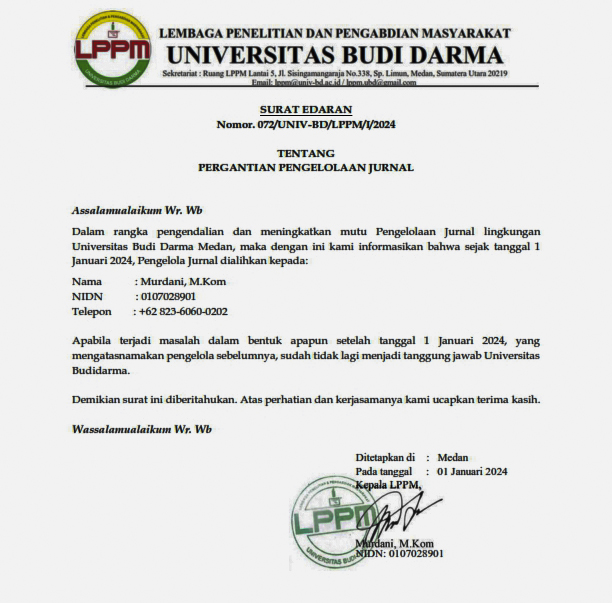Toxicity Analysis and Sentiment Classification of Wonderland Indonesia by Alffy Rev using Support Vector Machine
DOI:
https://doi.org/10.30865/json.v5i3.7563Keywords:
Wonderland Indonesia, Alffy Rev, Toxicity Analysis, Sentiment Classification, SVMAbstract
The music industry's increasing reliance on digital platforms like YouTube for dissemination raises concerns about the potential impact of music videos on viewer sentiment and well-being. This study seeks to assess the toxicity and sentiment of the Wonderland Indonesia music video by Alffy Rev through Support Vector Machine analysis, contributing to our understanding of the effects of music content on online audiences. This research addresses the challenge of sentiment classification in digital content by leveraging the Cross-Industry Standard Process for Data Mining (CRISP-DM) framework. The study aims to enhance sentiment classification accuracy by applying a Support Vector Machine (SVM) with a Synthetic Minority Over-sampling Technique (SMOTE) to address class imbalance issues. The research problem revolves around the need for robust sentiment analysis models capable of accurately discerning sentiment polarity within diverse datasets. Through the systematic application of CRISP-DM phases - business understanding, data understanding, data preparation, modeling, evaluation, and deployment - the study examines the efficacy of SVM with SMOTE in sentiment classification tasks. The findings demonstrate notable performance metrics, including accuracy (96.50%), precision (95.75%), recall (99.00%), and F-measure (97.34%). The AUC value substantially increases from 0.642 without SMOTE to 0.997 with SMOTE, highlighting its effectiveness in improving sentiment classification accuracy. In addition, The comparative analysis of toxicity values between the first and second videos demonstrates distinct patterns: the first video showcases a Toxicity score of 0.05290, with notable metrics such as Profanity registering at 0.04815. Conversely, the second video exhibits a slightly lower Toxicity score of 0.04744, with varying metrics such as Severe Toxicity at 0.01386.References
A. Tuomi, E. Moreira Kares, and H. Zainal Abidin, “Digital cultural tourism: older adults’ acceptance and use of digital cultural tourism services,†Scand. J. Hosp. Tour., vol. 23, no. 2–3, pp. 226–247, 2023, doi: 10.1080/15022250.2023.2256698.
X. Qin, X. M. Li, W. Chen, H. Tan, L. Luo, and X. Xu, “Tourists’ digital footprint: the spatial patterns and development models of rural tourism flows network in Guilin, China,†Asia Pacific J. Tour. Res., vol. 27, no. 12, pp. 1336–1354, 2022, doi: 10.1080/10941665.2023.2166420.
S. Seyfi, C. M. Hall, T. Vo-Thanh, and M. Zaman, “How does digital media engagement influence sustainability-driven political consumerism among Gen Z tourists?,†J. Sustain. Tour., vol. 31, no. 11, pp. 2441–2459, 2023, doi: 10.1080/09669582.2022.2112588.
D. Zheng, C. Huang, and B. Oraltay, “Digital cultural tourism: progress and a proposed framework for future research,†Asia Pacific J. Tour. Res., vol. 28, no. 3, pp. 234–253, 2023, doi: 10.1080/10941665.2023.2217958.
S. Menon, S. Bhatt, and S. Sharma, “A study on envisioning Indian tourism–Through cultural tourism and sustainable digitalization,†Cogent Soc. Sci., vol. 7, no. 1, 2021, doi: 10.1080/23311886.2021.1903149.
M. H. Dewantara, S. Gardiner, and X. Jin, “Travel vlog ecosystem in tourism digital marketing evolution: a narrative literature review,†Curr. Issues Tour., vol. 26, no. 19, pp. 3125–3139, 2023, doi: 10.1080/13683500.2022.2136568.
F. Frenzel, J. Giddy, and T. Frisch, “Digital technology, tourism and geographies of inequality,†Tour. Geogr., vol. 24, no. 6–7, pp. 923–933, 2022, doi: 10.1080/14616688.2022.2142843.
E. Ketter and E. Avraham, “#StayHome today so we can #TravelTomorrow: tourism destinations’ digital marketing strategies during the Covid-19 pandemic,†J. Travel Tour. Mark., vol. 38, no. 8, pp. 819–832, 2021, doi: 10.1080/10548408.2021.1921670.
M. Choi, Y. Choi, and D. Y. Kim, “Digital natives: internal defence mechanism to distrust tourism advertisements,†Curr. Issues Tour., vol. 26, no. 16, pp. 2692–2707, 2023, doi: 10.1080/13683500.2022.2095508.
M. I. Saleh, “From tourism in the Darkverse to tourism with digital detox: designing responsible Metaverse tourism experiences,†Curr. Issues Tour., pp. 1–21, 2024, doi: 10.1080/13683500.2024.2322694.
T. Deng, G. Wan, and M. Ma, “Impact of tourism companies digital transformation on employment: some evidence from China,†Asia Pacific J. Tour. Res., 2024, doi: 10.1080/10941665.2024.2324180.
C. Khoo et al., “Opportunities and challenges of digital competencies for women tourism entrepreneurs in Latin America: a gendered perspective,†J. Sustain. Tour., vol. 32, no. 3, pp. 519–539, 2023, doi: 10.1080/09669582.2023.2189622.
A. PawÅ‚owska-Legwand and Å. Matoga, “Disconnect from the Digital World to Reconnect with the Real Life: An Analysis of the Potential for Development of Unplugged Tourism on the Example of Poland,†Tour. Plan. Dev., vol. 18, no. 6, pp. 649–672, 2021, doi: 10.1080/21568316.2020.1842487.
R. Tang, “Digital economy and total factor productivity of tourism enterprises in China: the perspective of market competition theory,†Curr. Issues Tour., vol. 27, no. 1, pp. 76–91, 2024, doi: 10.1080/13683500.2022.2159338.
S. H. Tsaur, Y. L. Liao, and C. F. Tsai, “Analyzing the important implications of tourism marketing slogans and logos in Asia Pacific nations,†Asia Pacific J. Tour. Res., vol. 25, no. 4, pp. 355–368, 2020, doi: 10.1080/10941665.2019.1710223.
K. Berhanu and S. Raj, “The role of social media marketing in Ethiopian tourism and hospitality organizations : Applying the unified theory of acceptance and use of technology model,†Cogent Soc. Sci., vol. 10, no. 1, p., 2024, doi: 10.1080/23311886.2024.2318866.
R. Tang, “Digital economy drives tourism development—empirical evidence based on the UK,†Econ. Res. Istraz. , vol. 36, no. 1, pp. 2003–2020, 2023, doi: 10.1080/1331677X.2022.2094443.
A. M. Freitag and C. Camargo-Borges, “The Digital Bow: Exploring the Potential of Digital Presence for Indigenous Community-Based Tourism in Brazil,†Tour. Plan. Dev., pp. 1–18, 2024, doi: 10.1080/21568316.2024.2307974.
N. Martins, S. Dominique-Ferreira, and C. Pinheiro, “Bridging tourism, architecture, and sustainability: Design and development of an app for contemporary architecture built in Portugal,†J. Glob. Sch. Mark. Sci. Bridg. Asia World, vol. 32, no. 3, pp. 493–510, 2022, doi: 10.1080/21639159.2020.1808853.
C. Pasquinelli, M. Trunfio, G. Punziano, and G. Del Chiappa, “Online tourism experiences: exploring digital and human dimensions in in-remote destination visits,†J. Hosp. Mark. Manag., vol. 32, no. 3, pp. 385–409, 2023, doi: 10.1080/19368623.2023.2176963.
P. Kumar, J. M. Mishra, and Y. V. Rao, “Analysing tourism destination promotion through Facebook by Destination Marketing Organizations of India,†Curr. Issues Tour., vol. 25, no. 9, pp. 1416–1431, 2022, doi: 10.1080/13683500.2021.1921713.
S. Sharma, G. Singh, and S. Pratt, “Applying a technology acceptance model to understand digital-free tourism,†Tour. Recreat. Res., vol. 0, no. 0, pp. 1–18, 2023, doi: 10.1080/02508281.2023.2252680.
K. Minor, E. McLoughlin, and S. Carlisle, “The Digital Skills Gap–Is it Time to Rethink the Needs of Tourism and Hospitality Organizations in the UK?,†J. Hosp. Tour. Educ., vol. 00, no. 00, pp. 1–12, 2024, doi: 10.1080/10963758.2024.2316338.
E. Sánchez-Amboage, M. Enrique Membiela-Pollán, V. A. MartÃnez-Fernández, and S. Molinillo, “Tourism marketing in a metaverse context: the new reality of European museums on meta,†Museum Manag. Curatorsh., vol. 38, no. 4, pp. 468–489, 2023, doi: 10.1080/09647775.2023.2209841.
J. R. Saura, D. Palacios-Marqués, and D. Ribeiro-Soriano, “Digital marketing in SMEs via data-driven strategies: Reviewing the current state of research,†J. Small Bus. Manag., vol. 61, no. 3, pp. 1278–1313, 2023, doi: 10.1080/00472778.2021.1955127.
P. Tosun, A. Uslu, and E. Erul, “Connecting through chatbots: residents’ insights on digital storytelling, place attachment, and value co-creation,†Curr. Issues Tour., pp. 1–24, 2024, doi: 10.1080/13683500.2024.2316857.
F. Leal, B. Malheiro, B. Veloso, and J. C. Burguillo, “Responsible processing of crowdsourced tourism data,†J. Sustain. Tour., vol. 29, no. 5, pp. 1–21, 2020, doi: 10.1080/09669582.2020.1778011.
Y. A. Singgalen, “Selling vegetables through live streaming : sentiment and network analysis,†Int. J. Soc. Sci. Econ. Art, vol. 13, no. 4, pp. 240–254, 2024.
Y. A. Singgalen, “Social network and sentiment analysis of product reviews ( case of smartwatch product content ),†Int. J. Soc. Sci. Econ. Art, vol. 13, no. 4, pp. 255–267, 2024.
Y. A. Singgalen, “Toxicity and Social Network Analysis of Green Marketing Content for Electric Cars through Digital Media,†Int. J. Soc. Sci. Econ. Art, vol. 13, no. 4, pp. 268–280, 2024.
Y. A. Singgalen, “Analisis Sentimen Wisatawan terhadap Taman Nasional Bunaken dan Top 10 Hotel Rekomendasi Tripadvisor Menggunakan Algoritma SVM dan DT berbasis CRISP-DM,†J. Comput. Syst. Informatics, vol. 4, no. 2, pp. 367–379, 2023, doi: 10.47065/josyc.v4i2.3092.
Y. A. Singgalen, “Analisis Performa Algoritma NBC , DT , SVM dalam Klasifikasi Data Ulasan Pengunjung Candi Borobudur Berbasis CRISP-DM,†Build. Informatics, Technol. Sci., vol. 4, no. 3, pp. 1634–1646, 2022, doi: 10.47065/bits.v4i3.2766.
H. J. Christanto and Y. A. Singgalen, “Sentiment Analysis on Customer Perception towards Products and Services of Restaurant in Labuan Bajo,†J. Inf. Syst. Informatics, vol. 4, no. 3, pp. 511–523, 2022, doi: 10.51519/journalisi.v4i3.276.
Y. A. Singgalen, “Analisis Sentimen Konsumen terhadap Food , Services , and Value di Restoran dan Rumah Makan Populer Kota Makassar Berdasarkan Rekomendasi Tripadvisor Menggunakan Metode CRISP-DM dan,†Build. Informatics, Technol. Sci., vol. 4, no. 4, pp. 1899–1914, 2023, doi: 10.47065/bits.v4i4.3231.
Y. A. Singgalen, “Analisis Sentimen Wisatawan terhadap Kualitas Layanan Hotel dan Resort di Lombok Menggunakan SERVQUAL dan CRISP-DM,†Build. Informatics, Technol. Sci., vol. 4, no. 4, pp. 1870–1882, 2023, doi: 10.47065/bits.v4i4.3199.
A. Rydzik and C. S. Kissoon, “Decent work and tourism workers in the age of intelligent automation and digital surveillance,†J. Sustain. Tour., vol. 30, no. 12, pp. 2860–2877, 2022, doi: 10.1080/09669582.2021.1928680.
R. Tang, “A study of the effects and mechanisms of the digital economy on high-quality tourism development: evidence from the Yangtze River Delta in China,†Asia Pacific J. Tour. Res., vol. 27, no. 11, pp. 1217–1232, 2022, doi: 10.1080/10941665.2023.2174033.
T. Syvertsen, “Offline tourism: digital and screen ambivalence in Norwegian mountain huts with no internet access,†Scand. J. Hosp. Tour., vol. 22, no. 3, pp. 195–209, 2022, doi: 10.1080/15022250.2022.2070540.
M. Yaja and A. Kumar, “An empirical study of marketing of SMEs in the tourism sector,†Small Enterp. Res., vol. 28, no. 3, pp. 314–328, 2021, doi: 10.1080/13215906.2021.1962396.
R. Tang and J. Huang, “The influence of digital transformation on the resilience of tourism companies under the shock of the COVID-19 pandemic,†Asia Pacific J. Tour. Res., vol. 28, no. 8, pp. 827–840, 2023, doi: 10.1080/10941665.2023.2276469.
Downloads
Published
How to Cite
Issue
Section
License

This work is licensed under a Creative Commons Attribution 4.0 International License
Authors who publish with this journal agree to the following terms:
- Authors retain copyright and grant the journal right of first publication with the work simultaneously licensed under Creative Commons Attribution 4.0 International License that allows others to share the work with an acknowledgment of the work's authorship and initial publication in this journal.
- Authors are able to enter into separate, additional contractual arrangements for the non-exclusive distribution of the journal's published version of the work (e.g., post it to an institutional repository or publish it in a book), with an acknowledgment of its initial publication in this journal.
- Authors are permitted and encouraged to post their work online (e.g., in institutional repositories or on their website) prior to and during the submission process, as it can lead to productive exchanges, as well as earlier and greater citation of published work (Refer to The Effect of Open Access).





